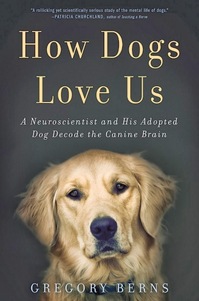Source of book image: http://2.bp.blogspot.com/-VIlNHG9gZ4M/Uo6zpfJTahI/AAAAAAAAU9U/9ASa-7VHHKc/s1600/a0c2a640e1085a57e07c368bfe5151f0_XL.jpg
(p. 40) Gregory Berns wasn’t sure if his pug Newton really loved him. Newton wagged his tail and gave kisses, but that wasn’t enough. Berns, a neuroscientist, wanted hard data. He also hoped to uncover “what makes for a strong dog-human bond” and how that might improve canine welfare. So he built a special M.R.I. machine, and trained dogs to lie still inside it, allowing him to study their brains. Though the results may seem obvious to dog lovers (that humans and dogs experience emotions similarly), they’re not a given for science. Berns’s book is a beautiful story about dogs, love and neurology that shows how nonhuman relationships are inspiring researchers to look at animals in new ways, for their benefit and ours.
For the full review, see:
REBECCA SKLOOT. “Release the Hounds.” The New York Times Book Review (Sun., December 8, 2013): 40.
(Note: the online version of the review has the date December 6, 2013.)
Book under review:
Berns, Gregory. How Dogs Love Us: A Neuroscientist and His Adopted Dog Decode the Canine Brain. New York: Houghton Mifflin Harcourt Publishing, 2013.
 “After training and hot dog treats, Callie is ready for an MRI.” Source of caption and photo: online version of the NYT review quoted and cited above.
“After training and hot dog treats, Callie is ready for an MRI.” Source of caption and photo: online version of the NYT review quoted and cited above.

